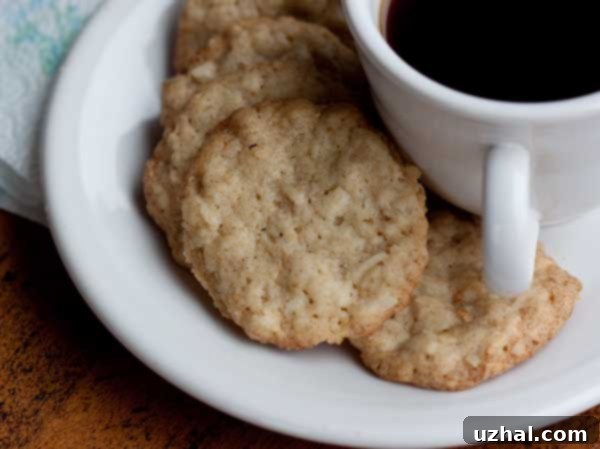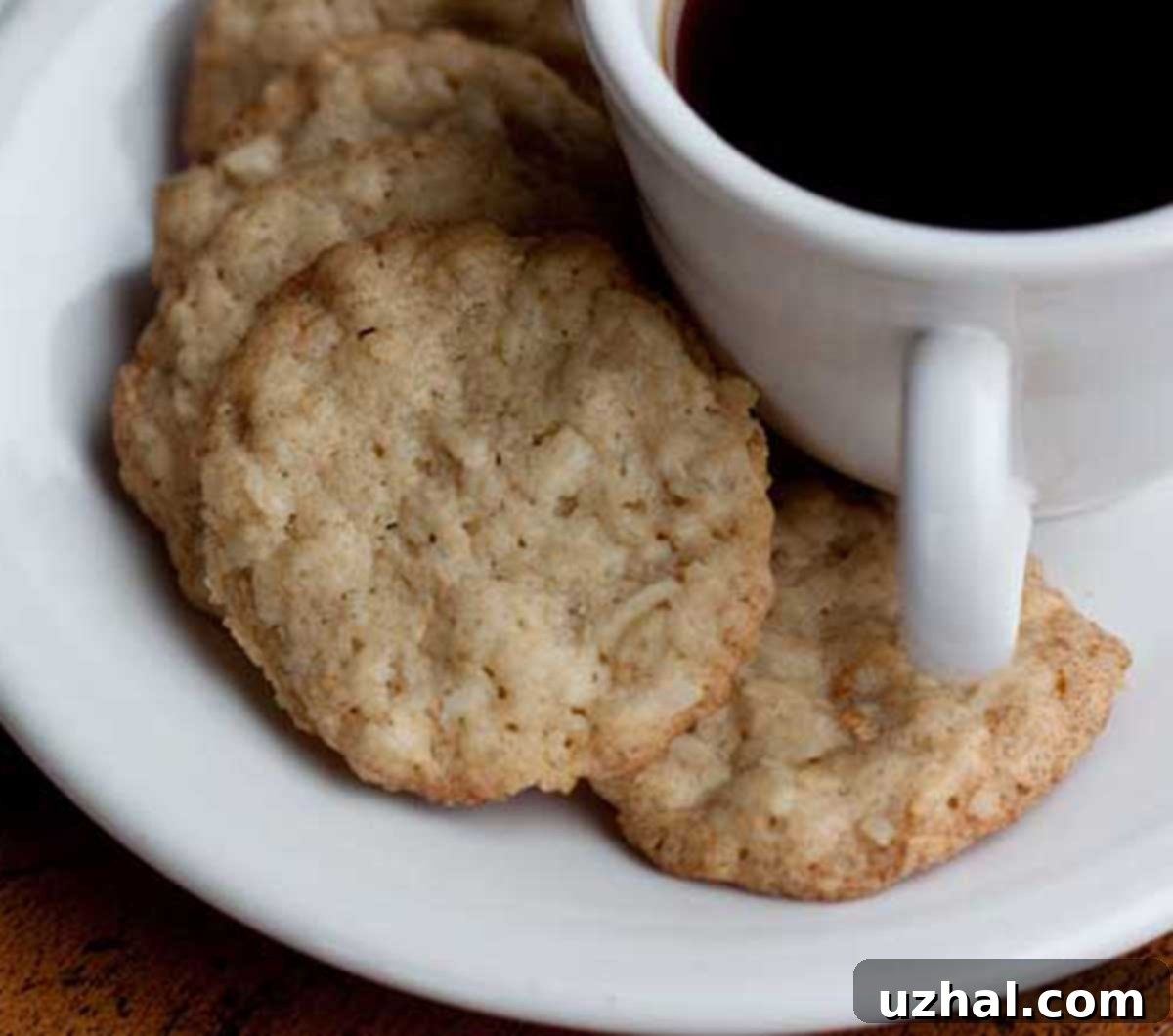Unlock Rich Flavor: Mastering Crispy Coconut Tea Cookies with Demerara Sugar
Embark on a culinary journey to elevate your baking with the humble yet extraordinary Demerara sugar. This particular recipe for Crispy Coconut Tea Cookies became a fast favorite shortly after I first discovered the magic of Demerara. Its unique qualities transform ordinary cookies into something truly special, offering a delightful crunch and a nuanced flavor that is hard to resist. While Domino brand’s Demerara sugar might be a little harder to find these days, replaced by their “Golden Sugar,” the quest for authentic Demerara is well worth it, or you can certainly explore alternatives if needed. But first, let’s delve into what makes Demerara sugar such a captivating ingredient.

What is Demerara Sugar and Why It’s a Baker’s Secret Weapon
Demerara sugar is often mistaken for or compared to turbinado sugar, and for good reason. Both are types of raw cane sugar, less processed than white granulated sugar, giving them a distinctive light brown color and larger crystals. However, Demerara holds its own unique charm. It originated in the British colony of Demerara, which later became Guyana in South America. Today, a significant portion of the world’s Demerara sugar comes from the beautiful island nation of Mauritius, a place that sounds as enchanting as the sugar itself. Its name itself evokes images of exotic lands and rich histories.
So, what exactly sets Demerara apart? It’s typically characterized by its large, golden-brown crystals and a delicate, subtle molasses flavor. This flavor is not as intense or overpowering as that found in dark brown sugar, but rather offers a gentle hint of caramel and toffee. This characteristic is precisely what makes it so appealing in baking, especially in recipes where you want to add depth without introducing excessive moisture or chewiness. Unlike highly refined white sugar, Demerara retains some of its natural molasses content, which contributes to its appealing color and nuanced taste. It’s truly a superior choice for adding a gourmet touch to everyday treats, acting as a secret ingredient for discerning bakers.
Demerara vs. Other Sugars: A Quick Comparison
- Granulated Sugar (White Sugar): Highly refined, neutral in flavor, small crystals, primarily provides sweetness.
- Turbinado Sugar: Similar to Demerara, also minimally processed with a light molasses flavor and larger crystals, often interchangeable with Demerara.
- Light Brown Sugar: Soft, fine crystals, higher molasses content, resulting in a moister, chewier texture and a more pronounced caramel flavor.
- Dark Brown Sugar: Even higher molasses content, very moist, strong caramel flavor, often used in rich, dense baked goods.
Demerara sugar strikes a perfect balance, offering the crunch and sparkle of larger crystals without the intense moisture of brown sugars. This makes it ideal for achieving a crispy texture, as it allows cookies to spread and crisp up beautifully, while the subtle molasses notes enhance the overall flavor profile without dominating it. It’s often used as a sprinkle on top of baked goods like muffins, scones, and pies, to add both visual appeal and a satisfying crunch. However, incorporating it directly into dough, as we do in this recipe, is where its magic truly shines through, enriching the entire cookie experience.
Why Demerara is Perfect for Crispy Coconut Tea Cookies
These Crispy Coconut Tea Cookies are traditionally made with granulated sugar, which yields a pleasant, straightforward sweetness. However, by swapping out half of the granulated sugar for Demerara, we introduce a new dimension of flavor and texture that elevates these cookies to an entirely new level. The larger crystals of Demerara sugar do not dissolve as readily as granulated sugar during baking, contributing to a wonderfully crisp bite and a slightly caramelized edge. This creates a delightful textural contrast that complements the chewiness of the oats and the delicate flakiness of the coconut.
The subtle molasses notes in Demerara sugar also harmonize beautifully with the tropical sweetness of the coconut and the earthy flavor of the oats. It adds a depth that plain granulated sugar simply cannot achieve, making each cookie more complex and satisfying. This isn’t just about adding sweetness; it’s about layering flavors and textures to create a truly memorable tea cookie. If Demerara sugar is elusive, you can certainly use natural cane sugar as a good alternative, or stick with regular white granulated sugar. The cookies will still be delicious, but the addition of Demerara is what transforms them into an extraordinary treat.
More Recipes to Explore with Unique Sugars
If you enjoy experimenting with different sugars and their impact on flavor and texture, here are a few other recipes from Cookie Madness that might pique your interest. These recipes showcase how varying types of sugar can dramatically change the outcome of your baked goods, offering new culinary experiences:
- Almond Crunch Brown Butter Banana Bread
- Cream Cheese Sugar Cookies
- Brown Sugar Chocolate Cake Cupcakes
- Brown Sugar Milk Chocolate Cookies
- The Best Sugar Cookies
Crispy Coconut Tea Cookies: The Recipe
Now, let’s get to the star of the show – the recipe itself. These cookies are surprisingly simple to make, requiring minimal prep time for maximum reward. They are perfect for an afternoon tea, a casual dessert, or just a delightful snack to brighten your day. The combination of butter, Demerara sugar, oats, and coconut creates a symphony of flavors and textures that will have you reaching for another, and another!
Recipe

Crispy Coconut Tea Cookies
Cookie Madness
Pin Recipe
Ingredients
- 1 1/2 cups unbleached all-purpose flour (approx. 200 grams)
- 2 teaspoons baking powder
- ¾ teaspoon salt**
- 1 cup unsalted butter (2 sticks, 230 grams, softened)
- ¾ cup granulated sugar (approx. 145 grams)
- ¾ cup Demerara sugar (approx. 145 grams)
- 1 teaspoon vanilla extract (or use ½ tsp. vanilla and ½ tsp. coconut extract for extra flavor)
- 1 large egg
- 1 ¼ cups old-fashioned rolled oats (not instant)
- 1 cup unsweetened coconut flakes (Trader Joe’s or similar quality recommended)
Instructions
-
Preheat your oven to 325 degrees F (160 degrees C). Line two large baking sheets with parchment paper to prevent sticking and ensure even baking.
-
In a medium bowl, whisk together the unbleached all-purpose flour, baking powder, and salt. Make sure these dry ingredients are well combined, then set the bowl aside.
-
In a large mixing bowl, using an electric mixer, cream together the softened unsalted butter and both types of sugar (granulated and Demerara) until the mixture is light and creamy. This should take about 2-3 minutes. Next, beat in the vanilla extract (and coconut extract, if using). Finally, beat in the large egg, scraping down the sides of the bowl frequently to ensure all ingredients are fully incorporated.
-
Gradually add the whisked flour mixture to the butter-egg mixture, stirring on low speed until just combined. Be careful not to overmix. Once the flour is mostly incorporated, fold in the old-fashioned oats and unsweetened coconut flakes until evenly distributed throughout the dough.
-
Scoop up rounded teaspoons of cookie dough. Roll the dough between your palms to shape them into small, uniform balls. Arrange these balls on your prepared baking sheets, ensuring they are about 2 ½ inches apart to allow for spreading. Gently press each cookie dough ball into a flat circle; this helps achieve that signature crispy texture.
-
Bake in the preheated oven for 15 minutes, or until the edges of the cookies are beautifully browned and the centers appear set. The baking time may vary slightly depending on your oven, so keep an eye on them. The cookies should be golden and fragrant.
Notes
Tips for Achieving Perfectly Crispy Cookies
While the recipe is straightforward, a few key tips can ensure your Crispy Coconut Tea Cookies turn out perfectly every time. First, make sure your butter is at room temperature – softened but not melted. This allows it to cream properly with the sugars, creating a light and airy base for your dough. When mixing the dry ingredients into the wet, mix just until combined. Overmixing can develop the gluten in the flour, leading to tougher cookies rather than the desired crispness.
Another crucial step is to properly space and flatten your cookies on the baking sheet. The 2 ½ inch spacing is important because these cookies will spread. Pressing them into flat circles before baking helps ensure they bake evenly and achieve that thin, crisp texture. Finally, resist the urge to open the oven door too often during baking, as this can cause temperature fluctuations that affect the cookie’s structure. Trust the baking time and rely on the visual cues—golden-brown edges and set centers—to tell you when they’re done. Once out of the oven, let them cool on the baking sheet for a few minutes before transferring to a wire rack; this helps them firm up and prevents breakage.
Serving and Storage Suggestions
These Crispy Coconut Tea Cookies are incredibly versatile. As their name suggests, they are an ideal companion for a warm cup of tea, whether it’s a robust black tea, a fragrant Earl Grey, or a calming herbal blend. They also pair wonderfully with coffee or a glass of cold milk for a comforting treat. Consider serving them as part of a dessert platter, or simply enjoy them on their own as a satisfying snack throughout the day. Their delicate crunch and rich flavor make them suitable for any occasion, from a casual gathering to a more formal tea party.
To keep your cookies at their freshest and maintain their crispness, store them in an airtight container at room temperature. They will typically stay fresh for up to a week. If you find they lose a bit of their crispness over time, you can briefly reheat them in a toaster oven for a few minutes (be careful not to burn them!) to revive their crunch. These cookies also make excellent gifts when packaged in decorative tins or bags, perfect for sharing the joy of homemade goodness with friends and family.
Conclusion: A Simple Recipe, Elevated by Demerara Sugar
In conclusion, these Crispy Coconut Tea Cookies are more than just a sweet treat; they’re a testament to how a single ingredient, like Demerara sugar, can significantly enhance a classic recipe. From its fascinating origins in Demerara and Mauritius to its unique flavor profile and crystal structure, Demerara sugar truly offers a touch of gourmet sophistication. It imparts a delightful crunch and a subtle caramel-like sweetness that perfectly complements the coconut and oats, making each bite an experience to savor. We encourage you to seek out this wonderful sugar and try this recipe. It’s a simple change that promises a big reward in flavor and texture, transforming your baking from good to truly exceptional. Happy baking!
